The Su-34 (also known as Su-27IB) fighter bomber has been developed by the Sukhoi Design Bureau Joint Stock Company in Moscow and the Novosibirsk Aircraft Production Association at Novosibirsk, Russia.
Su-27IB
The prototype of the attack plane for the front aviation, known as Su-27IB, was created by reengineering of one of mass produced training-combat Su-27UB’s. At the Novosibirsk plant named after V. P. Chkalov the new nose section with an armored cockpit was made, then installed on the modernized airframe of the two seater. The leading edges of the extended almost up to the cockpit wings now house fully rotatable horizontal canards or foreplanes. That has significantly changed the aerodynamics of the a/c improving its maneuverability and take off – landing characteristics (this technology was developed at first on a experimental T-10-24 in 1986 and was implemented on other Sukhoy designs such as carrier Su-27K for the fleet and multirole Su-35 for the Air Force). The air intakes were significantly redone becoming invariable (the high speed at high altitude had no importance for the fighter – bomber working mostly on a ground level with wings loaded with assorted armament). The engines and the engine nacelles were replaced as well.
 Su-27IB – Image: propro.ru
Su-27IB – Image: propro.ru
The visual differences from basic Su-27:
- New radar with enlarged nose cone.(1)
- Seat-by-seat cockpit(2)
- Two-weel nose gear(3)
- Resahped, flatten nose section of the fuselage(4)
- Canard foreplanes(5)
- Non-adjustable engine intakes(6)
- Larger tail-planes(7)
- No fin tips (8) under fuzelage
Source propro.ru
The Russian Air Force ordered an initial 32 Su-34 aircraft in 2008, with an additional requirement for 92 aircraft in 2012. The first two production aircraft were delivered to the Russian Air Force in December 2006. The export designation of the Su-34 is Su-32.
Production of the Su-34 bomber
Full-rate production began in January 2008. In the same month, the Russian Air Force stated that 70 aircraft would be procured by 2015. Sukhoi will deliver the Su-34 bombers to the Russian air force and army units until 2020, under a state contract with the Russian Ministry of Defence.
 Image: Encyclopedia of safety
Image: Encyclopedia of safety
The Russian Air Force received two Su-34 aircraft in December 2009. Four more Su-34 fighter-bombers were delivered in December 2010. Sukhoi’s Novosibirsk aircraft plant handed over another two Su-34s in December 2011. Five Su-34 aircraft were delivered in December 2012.
Sukhoi delivered five Su-34 frontline bombers to the Russian Air Force in January 2013, and a batch of Su-34 frontline bombers were delivered in October 2013.
Sukhoi transferred the final consignment of Su-34 front-line bombers to the Russian Air Force in December 2013, concluding the five-year state contract signed in 2008.
 Image: Encyclopedia of safety
Image: Encyclopedia of safety
Sukhoi delivered the first set of serial Su-34 frontline bombers to the Russian Air Force in June 2014, under the 2014 State Defence order. The second batch was delivered in July 2014 and a further delivery of Su-34 bombers was made in October 2014. An additional two bombers were delivered in December 2014.
Sukhoi delivered the first two batches of Su-34 aircraft to the Russian Ministry of Defence in May 2015, under the 2015 state defence order.
Su-27 Flanker based design of the Su-34
The Su-34 replaces for Tu-23M and Su-24 aircraft. It is one of a number of Russian aircraft, Su-30, Su-33 and Su-35, which are based and developed from the Su-27 Flanker.
 Image: ausairpower.net
Image: ausairpower.net
Su-30SM: Details
Su-33 (Su-27K) – Sea Flanker: Details
Su-35 Flanker-E: Details
The Su-34 design retains the basic layout and construction of the Su-27 airframe, with a conventional high-wing configuration and a substantial part of the onboard equipment. The Su-34 has a changed contour of the nose section to accommodate an advanced, multi-mode, phased array radar with terrain following and terrain avoidance modes. It has a two-seat rather than single-seat cockpit.
The capacity of the internal fuel tanks has been increased with a resulting increased take-off weight. Changes have been made to the central tail boom for rear-facing radar.
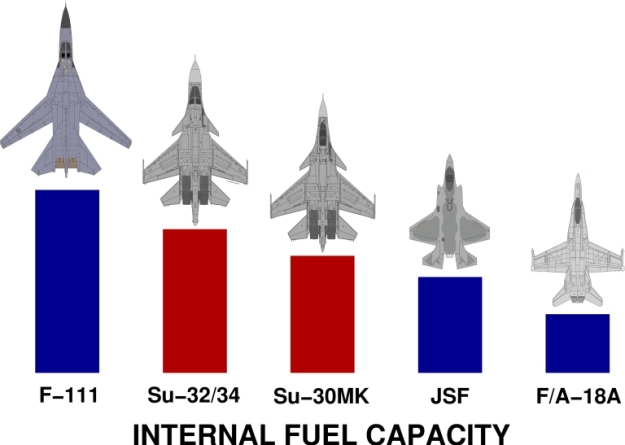 Image: ausairpower.net
Image: ausairpower.net
Su-32 Strike Flanker
For mysterious reasons, Su-32FN name was introduced for the former Su-34. From official announces this designation is introduced for navalized and export version of Su-34.
At the beginning of 1994 two experimental Su-34 bombers were built at a serial plant in Novosibirsk. These significantly differed from the prototype. They had new gear with a tandem set up of the wheels. Such a design allows the plane to use poorly prepared strips (and as a consequence a good combat survivability in the conditions when all the major runways are destroyed as it happened in Iraq in 1991) In the tail section of the fuselage, between the engines the engineers placed a powerful Radio Locating Station for aft observation. This forced the constructors to move the breaking parachute from the tail cone to the upper surface of the fuselage making it sliding, of “button” type. The regular equipment and systems were also placed on board of the plane.
One of the major combat modes of the Su-34 flight is an intrepid trust at low altitude following the terrain. However the plane based on the airframe of an air superiority fighter and having a wing with relatively low wing load (even though bigger than that of regular Su-27) will be subjected to excessive effect of the turbulence caused by the condition of the air mass’ close to the ground. This can adversely effect the crew’s physical capability to perform a lengthy low altitude flight and under certain circumstances can lead to a disaster (because of such reasons in particular the length of the low altitude section of the American McDonnell – Douglas F-15E “Strike Eagle’s” flight is limited; this a/c is also created on a base of an air superiority fighter and has a terrain following radar) For the Su-34 the low altitude flight comfort is achieved by using an automatic pitching oscillation suppression system (such an equipment is use only on the American strategic bomber Rockwell B-1B).
The combat experience of the low altitude aviation use was taken into consideration by the creators of the Su-34. The cockpit is made (the first time in the world practice on this type of a/c) in a form of an armored capsule with titanium walls up to 17 mm thick. The other vital construction elements have similar protection, particularly the fuel tanks and the engines. The total weight of the structural protection is 1,480 kg. All this in addition to the protection measures implemented on Su-27 (which had in particular fuel tanks with porous filling) provide the Su-34 with high degree of survivability in a low altitude flight over the territory reach in air defense measures.
Lately decreasing of radar, thermal and visual signature of a/c became a major element of guarantying their survival (Stealth technology). Even cursory look at the Su-34 gives an opportunity to make a conclusion that this plane has a smaller Radar Cross Section compared to the other craft in its class. Clearly visible integral arrangement of the airframe (the family feature of the all Su-27 family a/c) is combined with radically changed flatten nose section. The large “beak” of the radar sight is absent (the radar antenna and the air intakes are responsible for the size of the Radar Cross Section of a combat plane in the fore hemisphere). All this plus radioabsorbing covering and materials can make the Su-34 much less visible on a radar screen than such a/c as Su-24, F-111 and F-15E (according to the bureau representative at low altitude Su-34 will have the same radar visibility as modern cruise missiles, and as we know this class of weapons have Radar Cross Section less than 1 square meter)
 Su-34 – Images: propro.ru
Su-34 – Images: propro.ru
The visual differences from basic Su-27 (red marks) and predecessor Su-27IB (green marks):
- New radar with enlarged nose cone.(1)
- Seat-by-seat cockpit(2)
- Resahped, flatten nose section of the fuselage(3)
- Two-weel nose gear(4)
- Canard foreplanes(5)
- Non-adjustable engine intakes(6)
- Two-weel main gears(7)
- Larger tail-planes(8)
- New back-sphere radar with larger antenna(9)
- No fine tips uder fuzelage (10)
Source propro.ru
Defense Ministry announced modernization program of Su-34 in 2018: Here
Excerpt
Novosibirsk Aircraft Plant named after Chkalov begin modernization of the Su-34 bomber in 2018, he told reporters Deputy Defense Minister Yuri Borisov, who visited the company.
Russia may use Su-34 bomber to develop one-seat attack aircraft: Here
Excerpt
MOSCOW, November 1. /TASS/. A Russian multipurpose fighter bomber may get a one-seat variant as an attack aircraft, Russia’s Aerospace Force ex-commander and Chairman of the Federation Council Defense and Security Committee Viktor Bondarev told TASS on Wednesday.
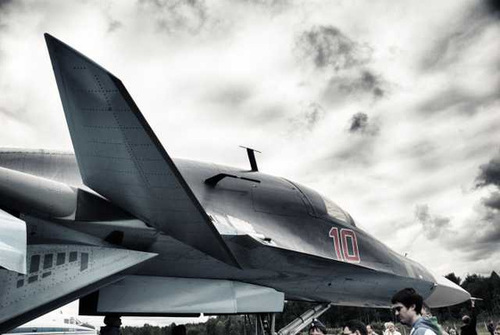 Images by Andre Dot
Images by Andre Dot
Su-34 cockpit
The cockpit has two K-36DM zero/zero ejection seats side-by-side for the pilot and co-pilot. The seats are supplied by Zvesda Research and Production Enterprise Joint Stock Company, Moscow. The multifunction displays in the cockpit show the flight parameters, the operational status of the aircraft units and tactical data.
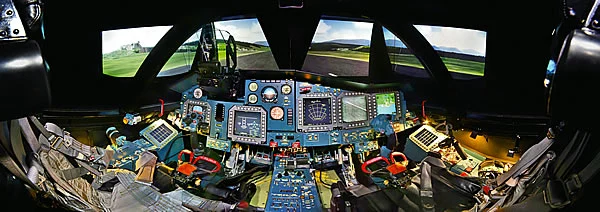
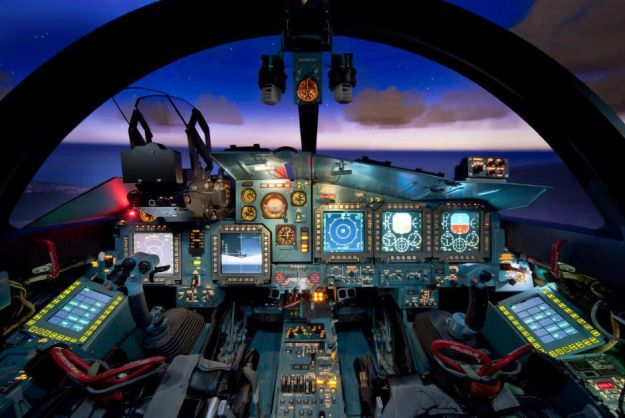
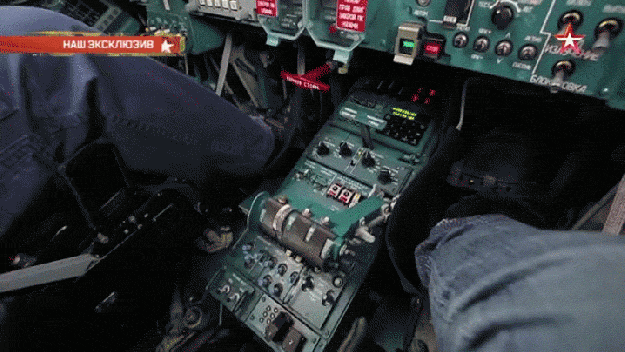 Center retractable control panel
Center retractable control panel
Production MFD in navigation mode
 Russian internet images – Source ausairpower.net
Russian internet images – Source ausairpower.net
Production MFD in moving map display mode
 Russian internet images – Source ausairpower.net
Russian internet images – Source ausairpower.net
 businessinsider.com
businessinsider.com
https://gfycat.com/CalmSameIberiannase
businessinsider.com
ZSh-7AP helmet
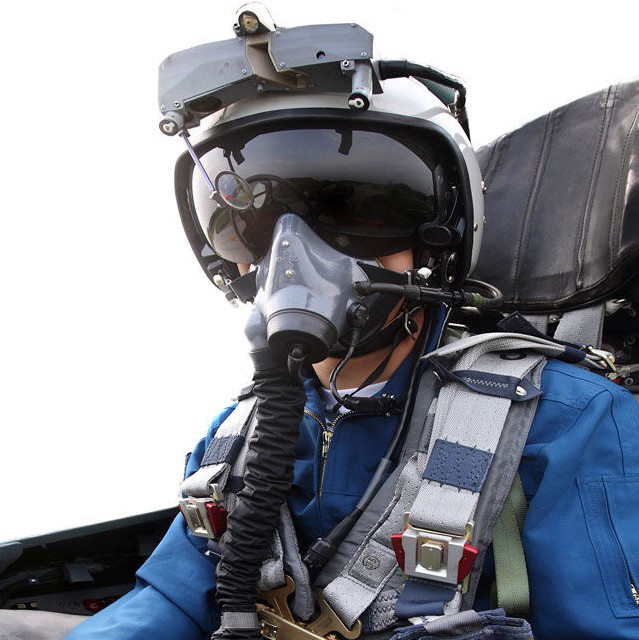
TKS-2/R-098 (Tipovyi Kompleks Svyazi) Intra Flight Data Link (IFDL)
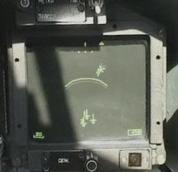
The encrypted TKS-2/R-098 (Tipovyi Kompleks Svyazi) Intra Flight Data Link (IFDL) which permits the networking of up to 16 Sukhoi fighters. It is not known whether the 5U15K-11 datalink designed for networking the A-50 AWACS and MiG-31 has been adapted to the Su-27/30, or whether a unique equivalent design is used. The TKS-2 was used effectively during the 2004 Cope India exercise against US F-15Cs. Source ausairpower.net
 Image: ausairpower.net
Image: ausairpower.net
Monolithic titanium-shielded capsule
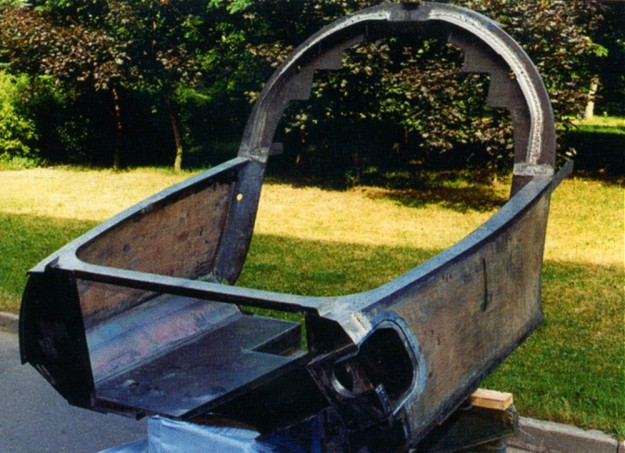 The entire Su-34 cockpit was built into a huge 17mm thick monolithic titanium-shielded capsule that weighs almost half a ton to protect the crew and avionics. Image: defesasaereas.blogspot.com
The entire Su-34 cockpit was built into a huge 17mm thick monolithic titanium-shielded capsule that weighs almost half a ton to protect the crew and avionics. Image: defesasaereas.blogspot.com
The entire Su-34 cockpit was built into a huge 17mm thick monolithic titanium-shielded capsule that weighs almost half a ton to protect the crew and avionics. Other vital parts of the aircraft also have additional protection, such as engines and fuel tanks (which in addition to the titanium shield are covered with rubber foam and are filled internally with a self-sealing polyurethane foam to prevent explosions). The total increase of the shield is of 1,480 kg. In order not to increase the weight of the vector much more components were implanted in composite materials and plastics that are lighter.However, the cockpit weight addition had to be compensated for by stretching the tail cone to balance the center of gravity of the aircraft.This type of shielding had never been deployed in a vector of this class, which was based on the experiences and vulnerabilities of vectors operating at low altitude such as Su-24 and Su-25. The crew was arranged side by side (Side by Side) with the pilot-commander on the left and the navigator – WSO (Weapon System Operator) on the right, aiming at not duplicating the electronic instruments and ensuring an excellent Visibility to the crew ahead and down the cockpit.
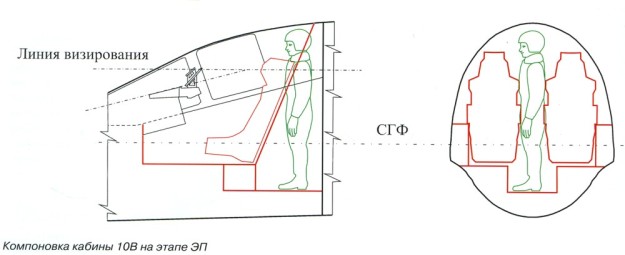 One of the most elaborate points in the Su-34’s development was the comfort and comfort of the cockpit, aiming to keep the crew with the least fatigue and fatigue possible, always maintaining high capacities of discernment, concentration and attention, to always be in Combat conditions in operations of up to 10 uninterrupted hours. – Image: defesasaereas.blogspot.com
One of the most elaborate points in the Su-34’s development was the comfort and comfort of the cockpit, aiming to keep the crew with the least fatigue and fatigue possible, always maintaining high capacities of discernment, concentration and attention, to always be in Combat conditions in operations of up to 10 uninterrupted hours. – Image: defesasaereas.blogspot.com
One of the most elaborate points in the development of the Su-34 was the comfort and comfort of the cockpit, aiming to keep the crew with the least fatigue and stress load possible, always maintaining high capacities of discernment, concentration and attention, maintaining the performance of the During the various hours of flight of each mission. For this, the designers worked to keep the ergonomic standards (the crew able to move inside the cabin), rest (the pilot and the navigator / operator are accommodated in the Zvezda K-36 DM ejection seats with better ergonomics and with A built-in massage system, one of the crew can lie down in the space between and behind the ejectable seats for rest), comfort (the cabin is pressurized and allows the crew to operate without oxygen masks up to 10,000 meters altitude, being Which are available for use in emergencies and combat situations, air conditioning system, upper canopies with curtains to prevent excessive entry of light into the cabin, to promote greater visual comfort to crew members during daytime operations), sanitation (The vector counts with bathroom), and food (the aircraft has an on-board kitchen composed of an electric oven to heat pre-cooked meals, a refrigerator and compartments for cutlery, plates, glasses, garbage, etc.) Integral and healthy during missions with several hours of flight. With these measures the Su-34 crew can carry out uninterrupted 10-hour operations and be in combat conditions. Translated by google – source defesasaereas.blogspot.com
К-36D-3,5 (К-36D-3,5М) Ejection seat
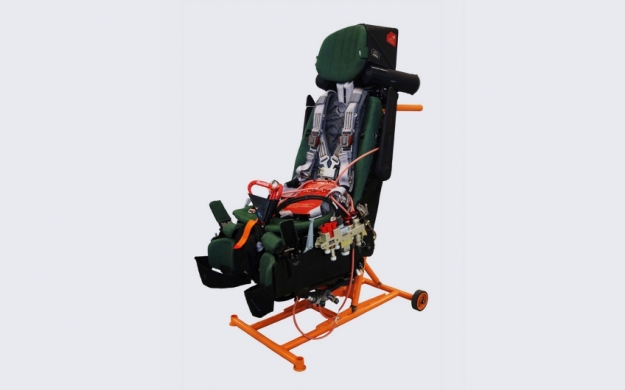
Design description:
In flight, a crewmember is held in the seat with a suspension/restraint harness system. The crewmember may be restrained in the seat with the shoulder and waist restraint mechanisms. The seat features stepless height adjustment, which makes the seat occupation comfortable for work and vision.
The crewmember protection against the dynamic pressure G-loads at ejection is provided with the protective gear, windblast shield, forced restraint in the seat, seat stabilization as well as the selection of one of three operation modes for the energy source depending on the suited pilot mass. At the aircraft speed exceeding 850 km/h, the MRM steady-state mode is adjusted by the automatics depending on the acceleration.
After automatic separation of the pilot from the seat, the recovery parachute canopy is inflated providing the pilot’s safe descent. A portable survival kit, which is separated from the seat together with the pilot, supports his/her vital functions after landing or water landing, makes the pilot search easier, and the ПСН-1 life raft supports the pilot floatation on the surface of water.
Specifications:
The К-36D-3,5 ejection seat realizes the crewmember emergency escape within the range of equivalent airspeed (VE.) from 0 to 1300 km/h, at Mach number up to 2.5 and aircraft flight altitude from 0 to 20,000 m, including takeoff, landing run and «Н=0, V=0» mode. The seat is used with the KKO-15 set of protective gear and oxygen equipment.
The seat installation mass does not exceed 103 kg, including the survival kit.
Year of development: 2001
Application:
The К-36D-3,5 family features seat modifications for each aircraft version.
The К-36D-3,5 seats are installed in all versions of the Su-30 aircraft; the К-36D-3,5M seats are installed in the MiG-29M and seaborne МiG-29К/KUB aircraft.
Source zvezda-npp.ru
Weapons on board the Su-34
 Image: .wikiwand.com
Image: .wikiwand.com
| Armaments | |
| 1. Guns | Onboard 30mm gun with 150 rds |
| 2. Guided air-to-air missiles | R-27R1(ER1) R-27T1(ET1) R-73E RVV-AYe |
| 3. Guided air-to-surface missiles | Kh-59ME Kh-31A, Kh-31P Kh-29T(TYe), Kh-29L S-25LD |
| 4. Guided bomb units | KAB-500KR, KAB-500L KAB-500KR, KAB-500L |
| 5. Air bombs | FAB-500T BETAB-500ShP ODAB-500PM OFAB-250-270 OFAB-100-120 P-50T Incendiary bombs |
| 6. Cluster bombs | RBK-500 SPBE-D |
| 7. Unguided missiles | S-8KOM, S-8OM, S-8BM S-13T, S-13OF S-25OFM-PU |
| 8. External fuel tanks | PTB-3000 (3,050 l) |
| 9. Suspension points | 12 |
Source sukhoi.org
The Su-34 is armed with a 30mm GSh-301 gun and 180 rounds of ammunition. The gun has a maximum rate of fire of 1,500 rounds a minute and the muzzle velocity is 860m/s. It is supplied by the Instrument Design Bureau in Tula.
GSh-301 30mm cannon

The Gryazev-Shipunov GSh-30 (ГШ-30) is a family of autocannons used on certain Russian military aircraft.
The GSh-30-1 (also known as “GSh-301”) is the standard cannon armament of most modern Russian fighters including the Yak-141 Freestyle, MiG-29 Fulcrum, Su-27 Flanker and its’ various derivatives. The GSh-30-2 is carried by the Sukhoi Su-25 Frogfoot ground attack plane and in external gun pods. The GSh-30-2K is a modified version with 2400mm long water-cooled barrels and variable rate of fire. It is used on a fixed mounting on Mi-24P Hind-F helicopters.
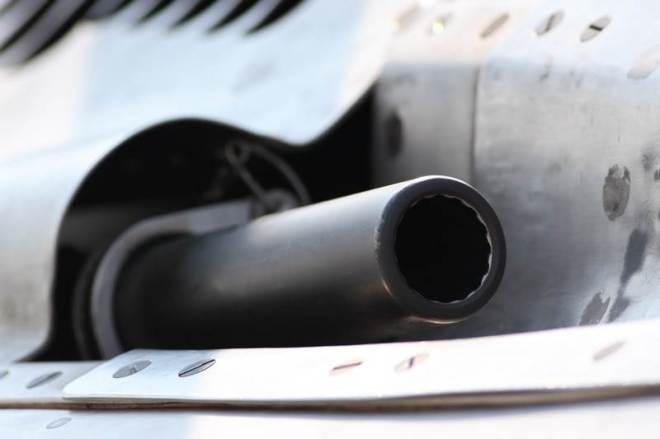 Closeup of the 30 mm GSh-30-1 cannon
Closeup of the 30 mm GSh-30-1 cannon
Gryazev-Shipunov GSh-30-1
- Caliber: 30x165mm
- Operaton: Gast principle
- Length: 1978mm
- Weight (complete): 46 kg
- Rate of fire: 1500–1800 rpm
- Muzzle velocity: 860 m/s
- Projectile weight: 386-404 g (13.6-14.25 oz)
- Mounting platforms: Yakovlev Yak-141 “Freestyle”, Mikoyan MiG-29 “Fulcrum”, Sukhoi Su-27 “Flanker” (and derivatives), Sukhoi Su-34 “Fullback”
GSh-30 Data imfdb.org
The aircraft has ten hardpoints for weapon payloads and is able to carry a range of missiles, including air-to-air, air-to-surface, anti-ship and anti-radiation missiles, guided and unguided bombs, and rockets. The aircraft is fitted with a target designator.
R-27 (NATO reporting name: AA-10 Alamo)
 Medium-range missiles R-27 (e), designed to intercept and destroy aircraft and helicopters of all types of unmanned aerial vehicles and cruise missiles in a dogfight at medium and long distances, with individual and group actions carrier aircraft, day and night, in simple and adverse weather conditions, from any direction, against the background of the earth and the sea, with active information, firing and maneuvering countering enemy.
Medium-range missiles R-27 (e), designed to intercept and destroy aircraft and helicopters of all types of unmanned aerial vehicles and cruise missiles in a dogfight at medium and long distances, with individual and group actions carrier aircraft, day and night, in simple and adverse weather conditions, from any direction, against the background of the earth and the sea, with active information, firing and maneuvering countering enemy.
Available in several versions, differing use of two types of homing – semi-active radar (PARGS) and heat – and two types of propulsion systems – with standard and increased installed power. Modifications PARGS are designated R-27R and R-27ER, with TGS – R-27T, R-27ET, with propulsion of increased energy available – R-27ER and R-27ET.
Main material rocket design titanium alloy, a steel motor housing .
For the suspension to the carrier aircraft and launch weight of both modifications missiles used the same launchers rail and catapult type.
The rail trigger APU-470 is used for the deployment of missiles under the wings of the aircraft, and the ejection device AKU-470 for the deployment of missiles under the fuselage and under the wings.
 Image: artem.ua
Image: artem.ua
R-27ER1 missile


R-27R1 missile


R-27ET1 missile


R-27T1 missile


Source artem.ua
 R-27 on Su-34 – Image: ipernity.com
R-27 on Su-34 – Image: ipernity.com
The R-73 (Nato codename AA-11 Archer) short-range, air-to-air missile is supplied by the Vympel State Engineering design Bureau in Moscow. The R-73 is an all-aspect missile capable of engaging targets in tail-chase or head-on mode. The missile has cooled infrared homing. The R-73 attacks the target within target designation angles of ±45° and with angular rates up to 60° a second. The missile can intercept targets at altitudes between 0.02km and 20km, target G-load to 12g, and with target speeds to 2,500km/h.
R-73E air-to-air missile

The R-73E/R-73EL small-range and close air combat air-to-air missiles are designed to engage various types of air targets, such as fighters, bombers, attack and military transport aircraft, approaching from any direction, by day and night, in conditions of ground clutter and enemy active countermeasures.
They feature an all-aspect IR passive homing head and ensure missile launch in accordance with the “fire-ad-forget” principle.
The missiles’ high agility is due to a unique combined gas/aerodynamic control system.
The missiles are powered by a one-mode solid-fuel rocket engine.
The R-73E missile modification is equipped with a radar proximity fuse/target sensor, while the R-73EL-with a laser proximity target sensor.

The missiles make part of weapon systems of MiG/Su type and other aircraft.
The missiles can be employed not only by fighters, but also by attack aircraft and helicopters.
The missile is carried under the carrier aircraft and launched in combat, or jettisoned in emergency, by means of the P-72-1D/P-72-1DB2 airborne rail launcher.
The missiles can be adapted for employment from foreign-made carriers in accordance with the technology, developed by the designer.
Performance:
| Launch range, km: | |
| head-on, max | 30 |
| tail-on, min | 0,3 |
| Target designation angle, ang.deg. | +;-45 |
| Target engagment altitudes, km | 0,02-20 |
| Max target g-load | up to 12 |
| Warhead type | rod |
| Warhead weight,kg | 8 |
| Launch weight, kg | 105 |
| Missile dimensions, m: | |
| length | 2,9 |
| body diameter | 0,17 |
| wing span | 0,51 |
| control plane span | 0,38 |
Source ktrv.ru
 R-73 on Su-34 – Image: ipernity.com
R-73 on Su-34 – Image: ipernity.com
The RVV-AE long-range air-to-air missile, also known as the RR-77 or by the Nato designation AA-12, is manufactured by Vympel. The missile can intercept targets at speeds up to 3,600km/h and altitudes from 0.02km to 25km. The minimum range in the aft hemisphere is 300m and the maximum vertical separation between the host aircraft and the target is 10km.
The RR-77 has inertial guidance with mid-course radio updates and terminal active guidance. A new, longer-range (150km) version of the R-77, with solid fuel ram-jet propulsion, is being tested by Vympel.
R-77 extended medium range air-to-air missile
The R-77, RVV-AE designation used for the export market and AA-12 Adder designation used by Western intelligence, is an extended medium range air-to-air missile featuring an active radar seeker to engage multiple airborne targets simultaneously. This missile was designed as the Soviet/Russian counterpart to the United States Air Force AIM-120 AMRAAM. The R-77 enables the Mig-29 and Su-27 fighter aircraft families to engage multiple airborne threats simultaneously thanks to its fire and forget capability. There are other versions fitted with infrared and passive radar seekers instead of active radar homing. Future plans call for increasing the missile range well beyond 150 kilometers.
The R-77 has been designed with innovative control surfaces which are one of the keys of its impressive performance. Once launched, the R-77 depends on an inertial navigation system with optional in-flight target position updates from the aircraft sensors. When the R-77 missile is at a distance of about 20 km its radar homing head activates leading the missile to its target.
Dimensions
Diameter: 200 millimeter
Length: 3.60 meter (11.8 foot)
Wingspan: 350 millimeter
Performance
Max Range: 80 kilometer (43 nautical mile)
Target’s Max Altitude: 25,000 meter
Target’s Min Altitude: 20 meter
Speed
Top Speed: 4 mach (4,782 kph)
Weight
Warhead: 30 kilogram
Weight: 175 kilogram (386 pound)
R-77 data deagel.com
Χ-59ME (Kh-59 ME)
The Kh-59 is a standoff, air-launched, air-to-surface weapon designed to engage ground and surface targets with pinpoint accuracy in optimal weather conditions. Its guidance system consists of an automatic navigation and control system which takes the weapon to the target’s area. A nose-mounted TV-sensor relays target area imagery to the launch airborne platform and the pilot selects the impact point. A bi-directional data link allows the pilot to select the impact point and re-target with the missile already in flight. The Kh-59 was introduced as the the Soviet counterpart to US SLAM standoff missile in the 1980s.
The Kh-59ME is an improved version of the Kh-59 standoff missile and was introduced in the early 1990s. It features two larger fragmentation and penetration warheads, minor airframe changes, and a new propulsion system for extended range. The missile can fly at altitudes between 7 and 1,000 meters. The nose-mounted TV-sensor relays target area imagery to the launch airborne platform and the pilot selects the impact point using the aircraft-mounted APK-9ME pod. The Kh-59ME improved standoff weapon has been integrated on Russian tactical attack aircraft such as the Mig-27 and Su-24. Source deagel.com
36MT turbofan engine
Design features
- 1-stage fan
- axial-diagonal high pressure compressor
- annular combustor
- 1-stage high pressure turbine
- 1-stage low pressure turbine
Specification
| Engine | 36МТ |
| Thrust at maximum rating, kgf | 450 |
| Maximum length, mm | 850 |
| Maximum diameter, mm | 330 |
| Weight, kg | <100 |
Source 36МТ npo-saturn.ru
| Design Bureau | “Raduga” |
| Launch altitude, m | 200-5.000 |
| Launch speed, km/h | 600-1.100 |
| Max launch range, km | 115 |
| Cruising altitude, km | 0,007 (sea)0,05, 0,1, 0,2, 0,6, 1 |
| Mach number | 0,72-0,88 |
| Warhead | Penetration or cluster |
| Guidance accuracy (CEP), m | |
| manual mode | 2-3 |
| automatic mode | 5-7 |
| Communications range, km | 140 |
| Launch weight, kg | 930 |
| Length, m | 5,7 |
| Wing span, m | 1,3 |
| Warhead weight, kg: | |
| – penetration WH | 320 |
| – cluster WH | 280 |
| Body diameter, m | 0,38 |
| Pod weight, kg | 260 |
| Pod length, m | 4,0 |
| Pod diameter, m | 0,45 |
Missile Technical data redstar.gr
New Grom air-to-surface missile undergoes flight tests on an Su-34 fighter-bomber
Sukhoi-30 SM/M2 & Su-34/35S may get Mach 10 hypersonic air-to-surface missile Knizhal
APK-9 datalink pod for the Kh-59ME
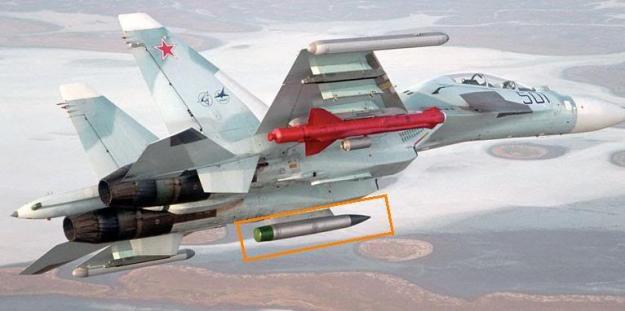 Kh-59ME Ovod M / AS-18 Kazoo and APK-9 Tekon pod on Su-30MK (KnAAPO image). – Image: ausairpower.net
Kh-59ME Ovod M / AS-18 Kazoo and APK-9 Tekon pod on Su-30MK (KnAAPO image). – Image: ausairpower.net APK-9 Tekon pod –Image: ausairpower.net
APK-9 Tekon pod –Image: ausairpower.net
Kh-31PD airborne high speed anti-radar missile
Kh-31PD airborne high speed anti-radar missile is designed to hit radars of anti-aircraft missile stations (ZRK).
Missile ground maintenance is provided by the OKA-E-1 aircraft guided weapons (AUSP) preparation system.
Performance:
| Maximum launch range, km | |
| (carrier flight parameters H=15km, M=1,5), km | 180 to 250 |
| Maximum launch range (H=0,1km), km | 15 |
| Launch altitudes, km | 0,1 to 15 |
| Launch speeds (M number) | 0,65 to 1,5 |
| Aiming system | inertial + wide waveband range |
| passive radio homing head | |
| Target location angle when launching, degree | |
| target lock being under carrier | +/-15 |
| target lock at the trajectory | +/-30 |
| Warhead: | |
| type | cluster, universal |
| weight | 110 |
| Fuel | gasoline |
| Missile start weight (maximum), kg | 715 |
| Missile overall dimensions: | |
| lengthxdiameterxwing span, m | 5,340×0,360×0,954 (1,102) |
| Weather conditions | any weather conditions |
| Carriers | aircraft Su-30MK (MKI, MKM, MK2), |
| Su-35, Mig-29, Mig-35, Mig-29KUB and etc. |
Source ktrv.ru
Russia’s Su-34 Hellduck Strike Fighter to Pack More Punch: Here
Excerpt
The Defense Ministry now wants to add to this impressive arsenal also anti-ship missiles, such as the modified Kh-35 missile and even plans to adapt the Su-34 to launch a new generation of the so-called aeroballistic missiles.
KH-15 (AS-16 KICKBACK) Kh-15 hypersonic air-to-ground aeroballistic missile
Even the fast KSR-5 left something to be desired. Storable rocket propellants are corrosive and highly toxic, making them difficult to handle, and the KSR-5’s range and capability were inadequate. In the 1970s, the US Navy developed the Grumman F-14 Tomcat interceptor, which featured long-range Phoenix air-to-air missiles. The Tomcat / Phoenix combination, backed up by the Grumman E-2C Hawkeye carrier-based radar early warning aircraft, presented a clear threat to Soviet bombers operating in the anti-ship role. The Hawkeye could provide long-range “eyes” for the Tomcat, which had long range and endurance, allowing it to fire a Phoenix at a Soviet bomber long before the Red aircraft got within range of a carrier group. If the bomber did manage to take a shot with a cruise missile, the Phoenix might well shoot the missile down.
The Tomcat / Phoenix / Hawkeye threat led the Soviets to develop the low-level launch versions of the Kh-22 and KSR-5 missiles, and also to work on a missile that was much harder to intercept. The Soviets were impressed enough by the Boeing SRAM that Raduga developed an equivalent, the “Kh-15 (AS-16 Kickback)”, which has almost the same external appearance as the SRAM. It was the first Soviet large ASM with solid-fuel rocket propulsion.
The Kh-15 is a simple spike of a missile with three tailfins. The resemblance to SRAM is so close that it is tempting to refer to the Kh-15 as “SRAMski”. Unlike SRAM, however, as with the other large Soviet ASMs, the Kh-15 was designed for both strategic and anti-ship attack. There are three versions: the standard Kh-15 nuclear-armed strategic variant, with inertial guidance only; a conventionally-armed anti-ship variant, the “Kh-15A”, with an active radar terminal seeker; and an antiradar variant, the “Kh-15P”, with a passive radar seeker. An export version of the Kh-15A, the “Kh-15S”, was also built. After launch, the missile climbs to the edge of space and then dives on the target steeply at Mach 5, making it very hard to hit.
Raduga began work on the Kh-15 in the late 1960s and it was accepted for service in the early 1980s. A Tu-22M Backfire bomber can carry six Kh-15s in a revolver launcher in the weapons bay, plus four more under the wings. It is also carried by the Tupolev Tu-160 Blackjack bomber. Source craymond.no-ip.info
Russian Sukhoi Su-34 Strike Fighter Spotted with New Kh-35U Anti-Ship Missile: Here
 A Kh-35U model fitted on a plane – Image: ruaviation.com
A Kh-35U model fitted on a plane – Image: ruaviation.com
Kh-35UE anti-ship missile
The Kh-35UE is a subsonic, sea-skimming anti-ship missile designed to engage amphibious assault ships and cargo vessels navigating individually or as part of a convoy from longer ranges than the basic Kh-35 missile. Like its predecessor, the new missile can be released from both fixed- and rotary-wing aircraft. The helicopter version is longer and heavier than the airplane version (4.4 meters versus 3.85 meters and 650 kg versus 550 kg) but can be released at lower altitudes (100-3,500 meters) and airspeeds (0-0.25 Mach). The guidance system has been improved to make the missile system more effective against advanced targets.
The Kh-35UE features an improved propulsion system which doubles the effective range of the cruise missile from 130 km to up to 260 km. It features a high-precision radio-altimeter and an active radar guidance system in the terminal phase of the flight. During the flight the Kh-35UE missile depends on the radio-altimeter and the Inertial Navigation System (INS). It is fitted with a 145 High Explosive (HE) fragmentation, penetration warhead.
Number of Stages: 2
Dimensions
Diameter: 0.42 meter
Length: 3.85 meter (12.6 foot)
Wingspan: 1.33 meter
Performance
Max Launch Altitude: 10,000 meter
Max Range: 260 kilometer (140 nautical mile)
Min Launch Altitude: 200 meter
Min Range: 7 kilometer
Speed
Cruise Speed: 0.80 mach (956 kph)
Max Launch Airspeed: 0.90 mach (1,076 kph)
Min Launch Airspeed: 0.35 mach (418 kph)
Weight
Warhead: 145 kilogram (320 pound)
Weight: 550 kilogram
Source deagel.com
Kh-29T(TE)
The Vympel Kh-29 / AS-14 Kedge is a Russian supersonic equivalent to the French AS.30 and US AGM-65 Maverick, and is primarily intended for interdiction and close air support, maritime strike roles, and attacks on hardened concrete shelters and structures. An APU-58 or AKU-58 launcher is used, on the Su-27/30 Flanker (up to 6 rounds), the MiG-27 Flogger (2 rounds), Su-17/22 Fitter (2 rounds) and Su-24M Fencer (3 round). Multiple variants exist.

The Kh-29T (Izdeliye 64 or AS-14B) is an electro-optical variant with a daylitgh television seeker. The Kh-29TE is the export variant, the Kh-29TM an enhanced variant. The Kh-29TD is another EO variant, possibly equipped with a thermal imaging seeker.
Launch weight for most variants is around 1,500 lb, with a 700 lb warhead being used most often. Range is usually cited at 16 nautical miles for a high altitude launch. Source ausairpower.net
Kh-29T
Missile weight: 680 kg
Length: 3900 mm
Diameter: 400 mm
Wingspan: 1100 mm
Minimum range*: 3 km
Maximum range: 8 – 12 km
Engine: fixed thrust solid, fuel rocket
Fuze type: impact
Guidance system: passive TV
Warhead: high-explosive penetrating
Warhead weight: 320 kg
Kh-29TE
Missile weight: 690 kg
Length: 3900 mm
Diameter: 400 mm
Wingspan: 1100 mm
Minimum range*: 3 km
Maximum range: 20 – 30 km
Engine: fixed thrust, solid fuel rocket
Fuze type: impact
Guidance system: passive TV
Warhead: high-explosive penetrating
Warhead weight: 320 kg
Source armamentresearch.com

Kh-29L

The Kh-29L (Izdeliye 63 or AS-14A) is a semi-active laser homing variant used in the manner of the AS.30L, with a 24N1 seeker. Source ausairpower.net
Kh-29L
Missile weight: 660 kg
Length: 3900 mm
Diameter: 400 mm
Wingspan: 1100 mm
Minimum range*: 3 km
Maximum range: 8 – 10 km
Height of launch: 0.2 – 5 km
Engine: fixed thrust, solid fuel rocket
Fuze type: impact
Guidance system: passive TV
Warhead: high-explosive penetrating
Warhead weight: 320 kg
Source armamentresearch.com
S-25LD Medium-range missile
| DESIGNER | “Zvezda” |
| Length, m | – |
| Diameter, mm | – |
| Fin span, mm | – |
| Weight, kg | 286 |
| Warhead type | High-explosive |
| Warhead weight, kg | 108 |
| Launch range, km | 11 |
| Guidance system | INS+lazer |
| Circle of equal probability, m | 15-10 |
| Speed, Mach | up to 1 |
Source redstar.gr
The Su-34 carries a range of precision-guided and unguided bombs and rockets, including the KAB-500 laser-guided bomb developed by the Region State Research and Production Enterprise based in Moscow.
KAB-500KR & KAB-500 OD guided and corrected air bombs
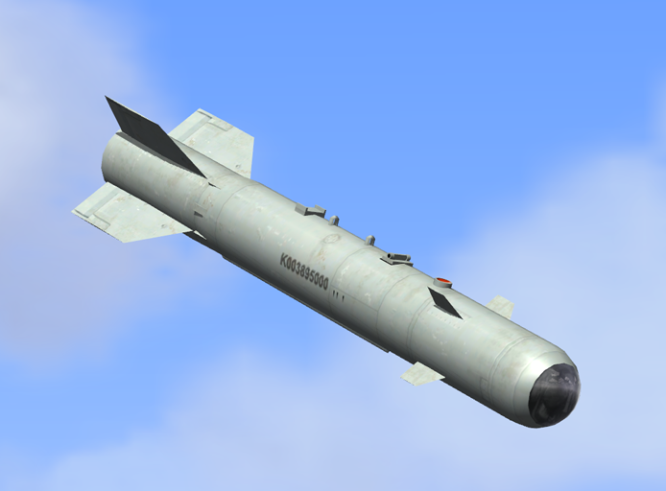
KAB-500Kr & KAB-500-OD are guided and corrected air bombs
The KAB-500Kr corrected air bomb is designed to engage stationary ground/surface small-sized hardened targets, such as reinforced concrete shelters, runways, railway and highway bridges, military industrial installations, warships, and transport vessels.
The KAB-500-OD corrected air bomb is designed to engage ground targets, such as fire emplacements, and manpower hidden in mountainous terrains.
The KAB-500Kr, KAB-500-OD corrected air bombs are fitted with TV/terrain-matching homing heads and various types of warheads. TV homers with target data processing correlation algorithm can “remember” target location and correct bomb’s flight trajectory until the impact on the target, thus realizing the “fire and forget” principle. Such homing heads can help defeat low-contrast and masked targets provided that terrain reference points and target coordinates related to them are available. The KAB-500Kr, KAB-500-OD corrected air bombs make part of weapon systems of such front-line aircraft types as Su-27, Su-30, Su-34, Su24M, MIG-29 and others.
 KAB-500Kr, KAB-500-OD – Image: justpaste.it
KAB-500Kr, KAB-500-OD – Image: justpaste.it
Performance:
| KAB-500Kr | KAB-500-OD | |
| Weights: total/warhead/HE, kg | 520/380/100 | 370/250/140 |
| Dimensions: | ||
| length, m | 3,05 | 3,05 |
| diameter, m | 0,35 | 0,35 |
| empennage, m | 0,75 | 0,75 |
| Bomb drop altitude, km | 0,5-5 | 0,5-5 |
| Carrier speed, km/h | 550…1100 | 550-1100 |
| Root mean square deviation, m | 4…7 | 4…7 |
| Warhead type | concrete-piercing | high explosive |
| (high explosive | (fuel-air | |
| penetrator) | explosive) |
Source ktrv.ru
FAB-500M62
FAB-500M54
OFAB-100-120


RBK-500 SPBE-D Cluster bombs
The RBK-500 SPBE was developed by NPO Bazalt in the 1980s, with the intent to produce a munition capable of engaging multiple armoured vehicles simultaneously. This work was awarded the State Prize of the USSR in 1991. Each RBK-500 SPBE contains 15 SPBE (samopritselivayushchiysya boyevoy element; СамоПрицеливающийся Боевой Элемент; self-guided submunition) submunitions, which use infrared seekers to target armoured fighting vehicles. The later model SPBE-D submunition employs a dual-mode IR seeker, whilst the SPBE-K also includes a radio frequency sensor. The latest submunitions can be operated in conjunction with an identification, friend or foe (IFF) system, however this is not believed to be a function of the SPBE model. The RBK-500 SPBE is similar in design, function, and use to the US CBU-97 Sensor Fuzed Weapon with its BLU-108 submunitions. However, whilst the CBU-97 is available with Wind Corrected Munitions Dispenser (WCMD) series modification kits which convert it to a precision guided munition (PGM), redesignated as the CBU-105, the RBK-500 SPBE is an unguided munition.
 Image: armamentresearch.com
Image: armamentresearch.com
The cargo munition functions after a predetermined time delay, ejecting the parachute-equipped submunitions. These spin in a controlled fashion, sweeping the area below for targets. Upon functioning, the SPBE series submunitions fire an explosively-formed penetrator (EFP), which is believed to be capable of penetrating approximately 70 mm of rolled homogeneous armour (RHA) at an angle of 30 degrees, from a distance of 100 m. Some details on the submunitions’ guidance and control can be found in a Russian patent, lodged by Bazalt in 2006. The technical specifications for the RBK-500 SPBE-D, believed to be very similar, and the SPBE submunition are given below. The later SPBE series submunitions are known to have a self-destruct function.
Technical Specifications – RBK-500 SPBE-D
Total weight: 500 kg
Overall length: 2485 mm
Diameter: 450 mm
Number of submunitions: 15
Delivery height: 400 – 5000 m
Delivery speed: 500 – 1200 km/h
Technical Specifications – SPBE
Total weight: 17.3 kg
Length: 384 mm
Diameter: 185 mm
Explosive weight: 5.8 kg
Source armamentresearch.com
S-8 rocket pod
‘S-8’ 80mm unguided rocket

The S-8 system is the main caliber weapon in the class of unguided aircraft rockets and can solve a variety of aircraft missions.
The rocket is provided with a solid propellant motor with a summary thrust pulse of 5,800 N.s and operating time of 0.7 s. Progressive methods for body shaping from ready-made rolled aluminum and unique engineering solutions in terms of separate elements aimed at reducing motor manufacturing labor consumption and costs are used in its construction.
The following types of S-8 rockets are operational today:
-
- S-8KOM with HEAT fragmentation warhead;
- S-8BM with concrete-piercing (penetrating) warhead;
- S-8-OM with illuminating warhead.
Weapon |
Type |
Guidance |
Range (km) |
Warhead (kg) |
Weight (kg) |
Speed (km/h) |
Intended Targets |
S-8
|
80 mm unguided aircraft rocket |
Unguided |
1.3-4 |
3,6 |
11.3 (pod 386) |
2196 |
20 x AT Fragmentation Rocket ,(400mm penetration) light anti-armor. This rocket is intended to engage modern tanks, lightly armored and soft-skinned combat materiel. Owing to the fragmentation effect, the rocket also inflicts damage on manpower |
S-8
|
80 mm unguided aircraft rocket |
Unguided |
6-7 |
9.2 |
16.7 (pod 402) |
– |
20 x HE Fragmentation Rocket , This rocket is designed to engage personnel, soft and lightly armored targets. |
S-8
|
80 mm unguided aircraft rocket |
Unguided |
1.3-3 |
3.6 |
11.1 (pod 382) |
– |
20 x Smoke, This rocket is intended to mark ground targets, routes of movement and landing areas in daytime. |
Source steamcommunity.com
B-13 unguided S-13 rocket pods
The S-13 is a 122 mm calibre unguided rocket weapon developed by the Soviet Air Force for use by military aircraft. It remains in service with the Russian Air Force and some other countries.
The S-13 rocket was developed in the 1970s to meet requirements for a penetrating weapon capable of cratering runways and penetrating hardened aircraft shelters, bunkers and pillboxes, to fill a gap between 80 mm and 240 mm rockets and fulfill a role similar to the 127 mm Zuni rocket. The S-13 is conventional in layout, with a solid rocket motor and folding tail fins that provide stability after launch.
The first trials were in 1973, but it was introduced only in 1983. S-13 rockets are shot from 5-tube launchers B-13L, that can be carried by most of Soviet and Russian attack and new fighter aircraft, like Su-17/20/22,Su-24, Su-25, Su-27, MiG-23BN, MiG-27, MiG-29. B-13L1 launcher is used by helicopters, like Mil Mi-24, Mil Mi-28, Ka-29TB, Ka-50, Ka-52.
S-13 rocket

Source su-27flanker.com
PTB-3000 (3,050 l) External fuel tanks
 Su-35 with PTB-3000 (3,050 l) External fuel tanks – Image: sabbathian.wordpress.com
Su-35 with PTB-3000 (3,050 l) External fuel tanks – Image: sabbathian.wordpress.com
Avionics
| Avionics | |
| 1. Avionics | |
| 1.1. Electronic countermeasures suite | |
| 1.2. Multi-purpose forward-looking PAA radar | |
| 2. Optical-electronic attack and navigation system | |
| 2.1. Information visualisation system | |
| 2.2. Onboard graphics station | |
| 2.3. Laser/TV station | |
| 3. Aeroplane control system | |
| 3.1. Autopilot system | |
| 3.2. Remote control system | |
| 4. Communications system | |
| 5. Integrated defensive aids suite | |
| 6. Kh-59ME missile preparation and telecommand homing equipment pod | |
| 7. Monitoring and recording system | |
| 7.1. Onboard automatic monitoring and display system | |
| 7.2. Unbiased monitoring equipment | |
| 7.3. Flight information recording equipment | |
Source sukhoi.org
Leninets B-004 multimode phased array radar
The primary aircraft sensor is the large Leninets B-004 multimode phased array radar, which uses like all current Russian designs passive phase shifter technology with a Travelling Wave Tube (TWT) transmitter. The radar is claimed to be highly modular with redundant components, reflecting the APQ-164 model to achieve very high mission reliability on long endurance sorties.
 Image: ausairpower.net
Image: ausairpower.net
The X-band design is claimed to achieve a 15 kW peak power rating, although production radars could see the use of higher rating TWT transmitters since developed for the NIIP BARS series. The powerful multimode enhanced-definition phased-array radar enables it to detect small-size ground targets and simultaneously track several aerial target in a track-while-scan mode. The radar features a ground-mapping mode and ensures nap-of-earth flying. The weapon control system ensures automatic missile launch with preset intervals and in assigned sequence. Source airrecognition.com
| General data: | |
| Type: Radar | Altitude Max: 0 m |
| Range Max: 296.3 km | Altitude Min: 0 m |
| Range Min: 0.4 km | Generation: Late 1990s |
| Properties: Identification Friend or Foe (IFF) [Side Info], Track While Scan (TWS), Pulse Doppler Radar (Full LDSD Capability), Interrupted Continuous Wave Illumination |
| Sensors / EW: |
| Slot Back [V-004] – (Su-34) Radar Role: Radar, FCR, Air-to-Air & Air-to-Surface, Long-Range Max Range: 296.3 km |
Slot Back [V-004] data cmano-db.com
Electro-optical system LTPS Platan [Attack LLTV]
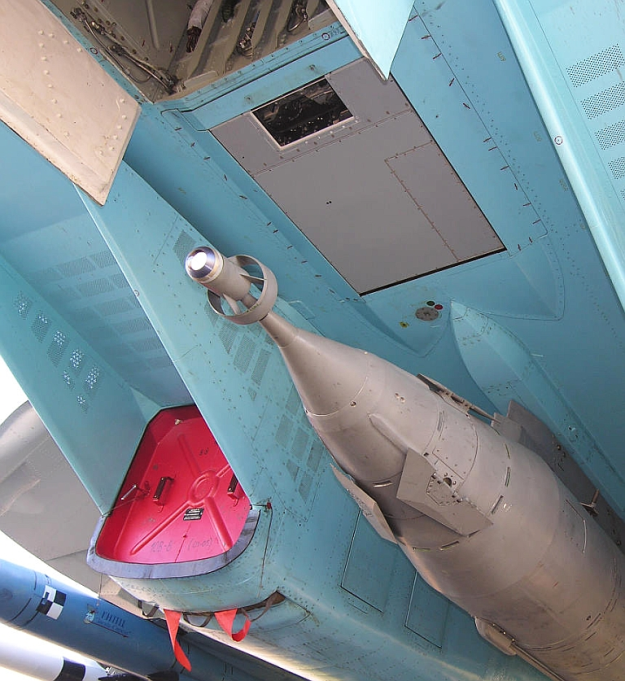
 Electro-optical system ventral aperture (Above 2 images)
Electro-optical system ventral aperture (Above 2 images)
| General data: | |
| Type: Visual | Altitude Max: 0 m |
| Range Max: 55.6 km | Altitude Min: 0 m |
| Range Min: 0 km | Generation: LLTV, 3rd Generation (2000s/2010s) |
| Properties: Identification Friend or Foe (IFF) [Side Info], Classification [Class Info] / Brilliant Weapon [Automatic Target Aquisition], Continous Tracking Capability [Visual], LLTV / NVG / CCD (Night-Capable) / Searchlight [Visual Night-Capable] |
| Sensors / EW: |
| LTPS Platan [Attack LLTV] – (Su-34) Visual Role: LLTV, Navigation & Attack Max Range: 55.6 km |
LTPS Platan [Attack LLTV] data cmano-db.com
Systems
The Su-34 is equipped with an electro-optical fire control system supplied by the Urals Optical and Mechanical Plant (YOM3) and a Geofizika FLIR (forward-looking infrared) pod. Leninetz of St Petersburg supplies the passive phased array radar system and TsNIRTI the electronic countermeasures suite.
Urals Optical and Mechanical Plant (YOM3)/ UOMZ Sapsan E
 The UOMZ Sapsan E (YOM3) Electro-Optical Targeting System pod
The UOMZ Sapsan E (YOM3) Electro-Optical Targeting System pod
Russian Su-34 Bomber Gets Unique New Recon Gear: Here
Excerpt
“The new system, dubbed the UKR-RT, is placed inside a container attached to the underside of the Su-34 (NATO reporting name — Full Back).
“Right now the UKR-RT system is undergoing field trials and will soon be supplied to the Air Force,” the an unnamed source told the newspaper.
The‘Fraktsiya’ – OESVR ‘Faction’ – Electro-Optical Target Designation and Tracking System – Developed by ‘TPK Lincos.’
 TPC Lincos E/O system; “Fraktsiya.” sensor’s
TPC Lincos E/O system; “Fraktsiya.” sensor’s
The Tu-214R’s ‘MRC-411’ or MRK-411 system is complemented by the ‘Fraktsiya’ or OESVR ‘Faction’ Electro-Optical high-resolution cameras developed by “TPK Lincos.”
They are real-time digital imagery transmitting, high-precision cameras that can track individual objects or provide wide-swath imagery of terrain in daylight, visible, low-light (LLTV), and Infra-Red.
The specifications from TPK Lincos are given as: “- +15 degrees in the longitudinal plane, and -+80 degrees in the transverse plane. Lens Focal Length: 1750mm, Thermal Imaging Channel -373mm.”
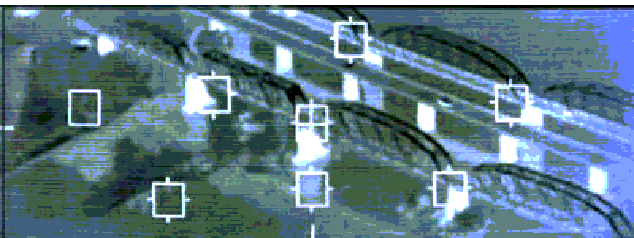 E/O target designation system targeting a bridge
E/O target designation system targeting a bridge
Source cyberevoblog.blogspot.com
Russia could equip its Su-34 strike fighters with UKR-RT ELINT pod: Here
Excerpt
The development of the UKR-RT began in the late 2000s. Open sources published several photos of the Su-34 tactical bomber (serial 47), taken during its test flights, with the plane carrying an advanced ELINT pod on the underbelly hardpoint between the air intakes. The pod was tested without its electronic innards. Its designers needed to select the optimal shape for it and the best place for it to be mounted on so that it does not hamper the aerodynamic performance of the bomber and the fuselage and wing panels do not hinder the ELINT pod’s performance.
 A Su-34 Fullback equipped with the UKR-RT ELINT pod (serial no. 47)
A Su-34 Fullback equipped with the UKR-RT ELINT pod (serial no. 47)
(Credit: Алексей Карпулев / russianplanes.net) – Image: worlddefencenews.blogspot.com
Expert Dmitry Boltenkov says that the mainstay of the UKR-RT advanced ELINT pod is the M-410 ELINT system. The M-410 is said to be a smaller version of the more sophisticated Fraktsiya system equipping the cutting-edge Tupolev Tu-214R ELINT/optronic intelligence aircraft. The weight and size were reduced, but the system is said to have retained the capabilities.
Interestingly, foreign military experts believe that the Tu-214R is a unique intelligence platform capable of developing the situation and detecting targets within a radius of several hundred kilometers. Aircraft of the type flew near Japan in late 2012, near the Russian-Ukrainian border in 2014-2015 and a Tu-214R has been operating out of Khmeimim AB in Syria of late.
Presumably, the Fraktsiya system will enable the Tu-214R both to intercept the signals of enemy radars, communications systems and even cell phones and to generate a real-time electronic map of the battlefield, using the data gathered.
“OPK” STARTS SERIAL PRODUCTION OF “ALL-SEEING” RADARS FOR COMBAT AIRCRAFT AND UAVS (“Peak-M”)
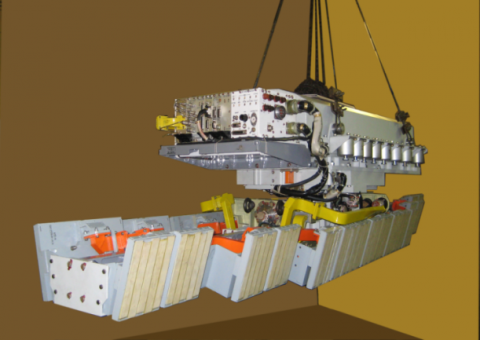 Image: alejandro-8.blogspot.com
Image: alejandro-8.blogspot.com
“The combined instrument-corporation” (part of the State Corporation Rostec) presented at the international exhibition “Gidroaviasalon 2016” pattern radar station (RLS) side-looking “Peak – M” to equip combat aircraft and unmanned aerial vehicles.
Fourth-generation radar “Peak – M” designed for radar surveillance, including for the detection of military targets of the enemy -. roads, airports, bunkers, fortifications, as well as weapons and military equipment
in the station has a function of processing radar data in real time, as well as provided a telescopic observation mode . resolution up to 30 cm in particular, the radar is able to detail “see” aircraft components – engine, keel, arms, etc., and to determine the characteristic features of its type.
The serial production of radar “Peak-M” in the “instrument-making of the Joint Corporation “is the Scientific-Research Institute” Pendant “. Initially, the product was developed for multipurpose fighter-bomber Su-34, but can be used on other types of aircraft, including drones.
“Peak-M” is part of the on-board complex RBB-3, capable of maintaining a radar surveillance in all weather conditions and at any time of the day. The station has a resolution in the map mode to 1-1.5 m, and the distance of objects detected -. 300 km
Radar has successfully completed the implementation of the state program of tests in 2016. At the same time, “NII Pendant” commissioned by the Industry and Trade Ministry is developing a technology to create a side-view of the fifth-generation radars with active phased array (AESA).
Source aviaport.ru
SPO-32 / L150 Pastel digital receiver
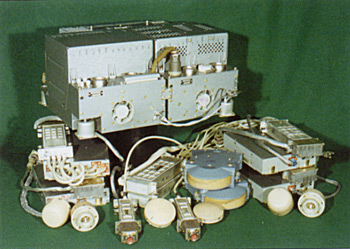
Pastel entered development in 1982, possibly as a reaction to poor performance of Soviet fighters in the Middle East. By 1983 the initial design was produced. It was intended for the Mi-28, MiG-29K/M, Su-27M and others.
Pastel is a family of new generation digital RWRs.
Su-25TM installation
Scans from 1.2-18GHz threat frequencies.
Accuracy is 3-5° with pinpoint location antenna, 10° in rough location antenna. 128 reprogrammable radar types. Detection range minimum of 120% of the radar’s range. 3 modes- operational target, programmed target, most dangerous target.
Detects and finds direction for pulse, pulse-doppler and CW mode radars in search, track and illumination modes. Classifies multiple threats by danger, with full display of all information about most threatening radar presented to crew. Controls EW systems, has the ability to control and assign targets to 6 anti-radiation missiles such as the Kh-31. Aural warnings for high threat situations.
Pastel may be made available for upgrade packages or built into new export models of the Mig-29 and Su-27 families. Source aerospace.boopidoo.com
| General data: | |
| Type: ESM | Altitude Max: 0 m |
| Range Max: 222.2 km | Altitude Min: 0 m |
| Range Min: 0 km | Generation: Early 2000s |
| Sensors / EW: |
| SPO-32 Pastel [L-150] – ESM Role: RWR, Radar Warning Receiver Max Range: 222.2 km |
SPO-32 Pastel [L-150] data cmano-db.com
APP-50 IR decoy dispenser
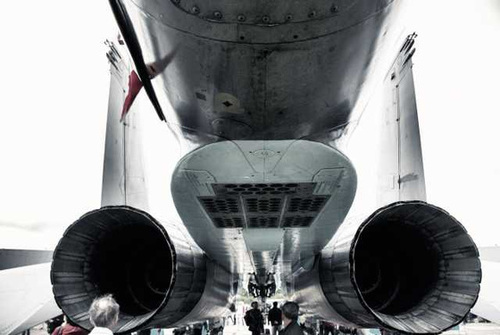 Chaff dispensers – Image: ipernity.com
Chaff dispensers – Image: ipernity.com
The APP-50 passive jamming automatic units (decoy dispensers) are designed to protect aircraft from engagement in flight by airborne missile systems and air defence missile/artillery systems by dispensing radar/IR interference rounds. The dispensers are installed onboard aircraft, and can be controlled manually (from the control panel) or automatically. The APP-50 dispensers can be delivered in two variants: APP-50P for autonomous operation; APP-50A for integration into onboard electronic support systems. The dispenser can launch rounds (up to three types) in continuous, salvo, combined and emergency modes. Launch time intervals, number of salvos and number of rounds in one salvo (from 1 to 4) are set by operator or by the electronic support system.
Developer and manufacturer: Gorizont JSC
Performance:
| Launch altitude envelope, m | 0 – 30, 000 |
| Launch time intervals, sec | 0,1 – 8,0 |
| Round types | PRP-50, PPI-50 |
| Caliber, mm | 50 |
| Number of rounds | 24 |
| Dispenser weight (loaded), kg | 53 – 56,5 |
| Launch modes | continuous, salvo, by series |
Data ktrv.ru
KNIRTI SAP-518 self-protection ECM pod
An Su-34 Fullback demonstrator photographed at Kubinka in September, 2009, equipped with new wingtip mounted KNIRTI SAP-518 self-protection ECM pods, and a large centreline KNIRTI SAP-14 “Escort Jammer” support jamming pod. The new SAP-14 is analogous to the US ALQ-99E series pods, but employs a fundamentally different antenna arrangement optimised to suppress emitters in the forward and aft hemispheres of the escort jamming aircraft. The pod has been cleared for carriage on the Su-30MK Flanker G/H airframes and the Su-34 Fullback
The heavyweight high power KNIRTI SAP-14 Support Jammer ECM pod is a Russian analogue to the US ALQ-99E pod carried on the EA-6B Prowler and EA-18G Growler. It was developed for Flanker family aircraft and is carried on a large centreline pylon. To date little has been disclosed about this design, but it has been observed on the Su-30MK Flanker G/H and Su-34 Fullback. It operates between 1 GHz and 4 GHz (© 2009 Vitaliy V. Kuzmin).
The KNIRTI SAP-518 ECM pod is a new technology replacement for the established L005 Sorbstiya series wingtip ECM pods. It operates between 5 GHz and 18 GHz (© 2009 Vitaliy V. Kuzmin). Source ausairpower.net
Engines and performance
First production aircraft are powered by two after-burning NPO Saturn AL-31F turbofan engines. Later aircraft may be fitted with MMPP Salyut AL-31F-M2/3 or NPO Saturn 117 engines. They are mounted under the wing and are equipped with all-duty fixed geometry air intakes. A rotor protection installed in the air intakes provides protection against the ingestion of foreign objects.
АЛ-31Ф (AL-31F)
Turbofan engines with afterburner
Engine type – two-shaft mixing with the flow of internal and external contours of the turbine common to the two circuits afterburner and variable supersonic nozzle jet vserezhimnym. The engine is designed to be installed on the Su-27 and its modifications (Su-30MK, Su-33, Su-34 and others.). AL-31F has a wide operating range of applications, has a high dynamic stability and durability, reliably in extreme conditions, the level of non-uniformity and air pressure fluctuations at the inlet. The engine operates reliably in a flat spin. The engine ensures a unique aircraft maneuverability, including the performance of highly dynamic maneuvers. Installation of the nozzle with a controlled thrust vector control (optional)
 Image: ipernity.com
Image: ipernity.com
| Design | modular |
| Maximum thrust, kgf | 12500 |
| The minimum specific fuel consumption, kg / kgf * h | 0.685 |
| Air flow rate, kg / s | 112 |
| Diameter of the inlet, m | 0.905 |
| Overall dimensions, mm | 1140 |
| Maximum length, m | 4,945 |
| Dry weight, kg | 1520 |
Engine data salut.ru
The aircraft can carry 12,100kg of fuel internally in two fuel tanks in the wings and four in the fuselage. Three external fuel tanks, each with a capacity of 3,000l, can also be fitted.
The aircraft can achieve a speed of 1,900km/h (Mach 1.6) at altitude and 1,300km/h (Mach 1) at sea level, and has a flight range of 4,000km.
TA14-130-35 APU
TA14-130-35 is a state-of-the-art gas-turbine engine with the power up to 105 kW. This engine is designed for SU-35 aircraft APU. It is used for supplying on-board AC electric power 200/115 V, up to 30 kV and providing air conditioning for cockpit and cabin.
The engine is equipped with a highly efficient turbo compressor and integrated system of oil cooling. As a result, fuel consumption and the weight are reduced.
 APU air inlet grill
APU air inlet grill
The engine is compliant with the contemporary engineering requirements and is equipped with a full-authority electronic digital control system that provides regulation, control and error detection as well as operating time count. *Note same APU model as Su-35
 APU exhaust the metal flap on top of the tail cone tip
APU exhaust the metal flap on top of the tail cone tip
Technical features:
| Absorbed electric power of AC, kVA | 30 |
| Bleed air consumption, kg/s | 0,55 |
| Bleed air pressure, kgf/sm2 | 3,70 |
| Bleed air temperature, °C | 210 |
| Start and operation altitude, m | 10000 |
| Environmental temperature, °С | ± 60 |
| Weight (without generator), kg | 62 |
| Overall dimensions, mm | 868х481х426 |
APU data Source aerosila.ru
Operators: Here
 Image: combataircraft.com
Image: combataircraft.com
Specifications
| Aircraft performance | |
| Normal takeoff mass, kg | 38,240 |
| Maximum ordnance, kg | 8,000 |
| Service ceiling (without external ordnance and stores), km | 15 |
| Maximum flight speed at sea level (without external ordnance and stores), km/h | 1,400 |
| Maximum flight speed at altitude (without external ordnance and stores), km/h | 1,900 |
| G-limit (operational) | 9 |
| Maximum range, km | 1,100 |
| Ferry range, km | 4,000 |
| Maximum airborne time (pilot-dependent), hours | 10 |
| Aeroplane dimensions: | |
| – length, m | 23.34 |
| – wingspan, m | 14.7 |
| – height, m | 6.09 |
| Crew | 2 |
| In-flight refuelling system | |
| Maximum flow rate (at entry pressure of 3.5 kg/cm 2), l/min | 1,100 |
| Powerplant | |
| Number and type of engines | 2 x AL-31F |
| Thrust in afterburner, kgf | 12,500 -2 % |
Specification Source sukhoi.org
Main material source airforce-technology.com
Revised Mar 11, 2017
Updated Dec 21, 2017






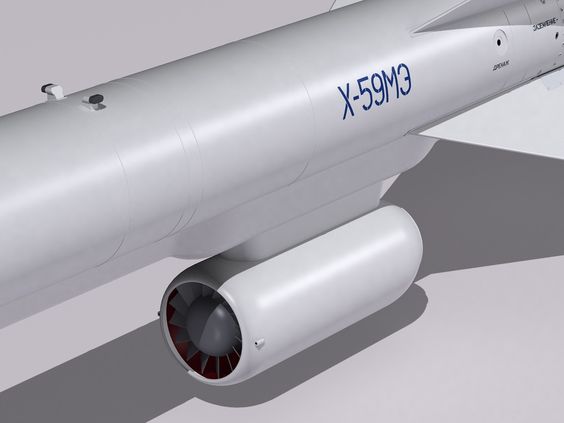



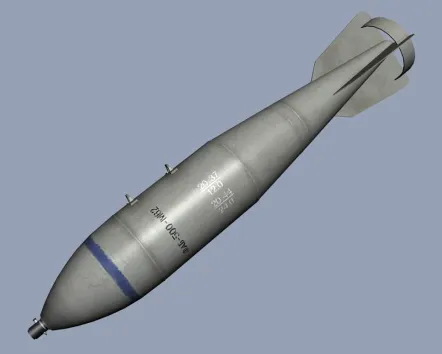
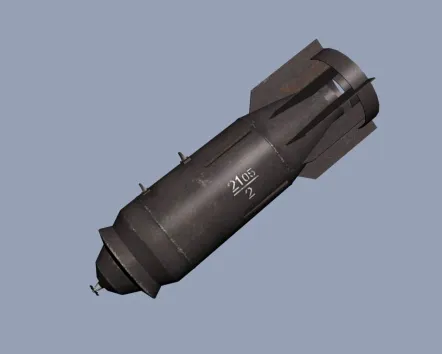



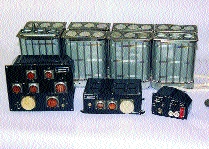

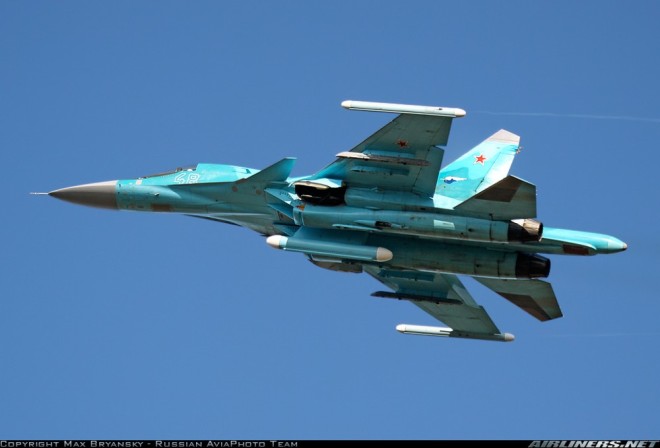
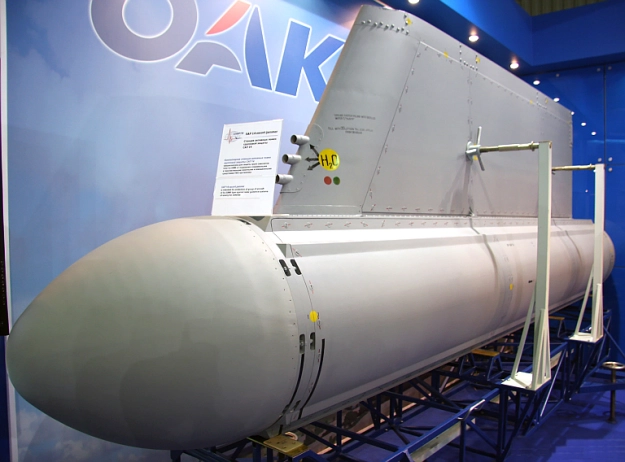





The SU-34 is Russia’s answer to America’s F-111. I would bet that countries would line up wanting a plane that can do F-111 like missions.
LikeLike